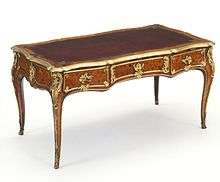Writing table

A writing table (French bureau plat) has a series of drawers directly under the surface of the table, to contain writing implements, so that it may serve as a desk. Antique versions have the usual divisions for the inkwell, the blotter and the sand or powder tray in one of the drawers, and a surface covered with leather or some other material less hostile to the quill or the fountain pen than simple hard wood.

In form, a writing table is a pedestal desk without the pedestals, having legs instead to hold it up. This is why such tables are sometimes called leg desks.
The writing table is often called a "bureau plat" when it is done in a French style such as Louis XVI, Art Nouveau, etc. When a writing table is supported by two legs instead of four, it is usually called a trestle desk.
The writing table is also sometimes called a library table, because it was often placed in a rich individual's library. This was the room in a house where a gentleman would keep literature and also do his business transactions. The library often housed, in addition, a round desk called a rent table and sometimes a drawing table. The term library table is sometimes applied indiscriminately to a wide variety of desk forms, in addition to being used for writing tables. Let the scholar or the buyer be wary.
Some writing tables have additional drawers built above the surface. In this case they are often called bureau à gradin instead of writing table, unless they have a more specific form, such as that of a Carlton House desk.

A reading and writing table with an easel or double easel for books that was adjustable on a ratchet and a drawer fitted for writing implements was a mid-18th century English invention[1] that lasted as long as the habit endured of reading while standing.
As with many other desk forms antique writing tables were sometimes built with what was, at the time, a complex mechanism of gears and levers to make sections slide out or pop up when certain panels were pulled. In this case, one sometimes called them a mechanical desk.
See also
Notes
- ↑ Design XXIV in Ince and Mayhew's Universal System of Household Furniture, London, 1759-62, noted in John Gloag, A Short Dictionary of Furniture, rev. ed, 1969, s.v. "Reading Tables".
References
- Gloag, John. A Complete Dictionary of Furniture. Woodstock, N.Y. : Overlook Press, 1991.
- Oglesby, Catharine. French Provincial Decorative Art. New YorkCharles Scribner's Sons, 1951.
- Romand, Didier. L'argus des meubles. Paris: Balland, 1976.
- Souchal, Genevieve. French Eighteenth Century Furniture. Translated by Simon Watson Taylor. London: Weidenfeld and Nicolson, 1963.